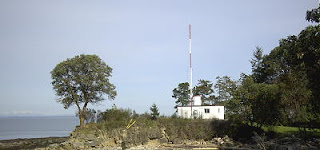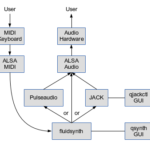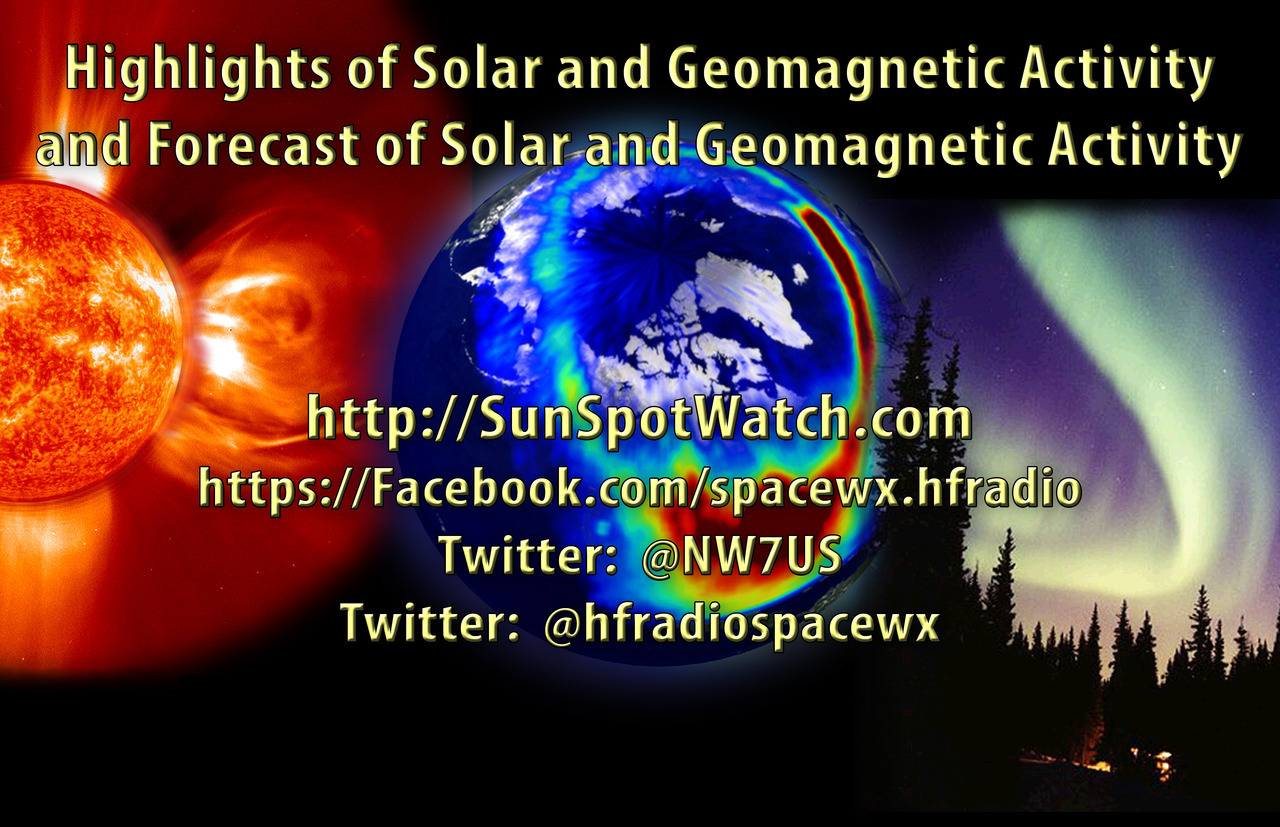 Hunting For NDBs in CLE 236
Hunting For NDBs in CLE 236
 |
| AP-378 Mayne Island, BC |
How time flies. Once again it's a CLE weekend. It seems like the last one was just a week ago!
'CLE's are 'Co-ordinated Listening Events, and NDB DXers around the world focus their listening time on one small slice of the NDB spectrum.
This time the hunting ground is the 15 kHz slice from 370.0 - 384.9 kHz.
This is a somewhat dreaded range for me since my local blowtorch NDB, 'AP' (378 kHz), sits right in the middle of the range. 'AP' is located at the entrance to Active Pass, the main ferry route to Vancouver Island, and the antenna is about 3/4 of a mile down the beach from me. Needless to say, the beacon is about 40db over S9! With careful loop nulling, I can reduce this by about 25db but it's still an enormous signal to deal with.
Hopefully you can put 'AP' in your own log this weekend but its 25-watt signal will be much weaker for you. It's been logged as far east as Illinois and with your receiver in the CW mode, can be found on 378.399 kHz.
All too often our CLE weekends get hammered by geomagnetic disturbances, possibly because our monthly schedule syncs up nicely with the Sun's rotation and the disturbance from the previous month once again rotates into position. Conditions this time surely can't be much worse than for our previous event and today's mid-week check looks promising.
 |
| courtesy: NOAA |
 |
| courtesy: NOAA |
Things seem geomagnetically quiet at the moment so lets hope they stay that way. LF and MF propagation can often be amazing in the fall and as summer storms start to dissipate, the band can become much less noisy.
From CLE coordinator Brian Keyte (G3SIA), comes the following CLE info:
Hi all,
Please join us in our 236th coordinated Listening Event which starts
this Friday and celebrates the arrival of the Equinox this weekend.
CLEs are not contests - if you enjoy taking part you will be a winner!
Days: Friday 21 September - Monday 24 September
Times: Start and end at midday, LOCAL TIME at the receiver
Range: 370 - 384.9 kHz
Just log all the NDBs that you can identify with their nominal (listed)
frequencies in the range (it includes 370 kHz, but not 385 kHz)
plus any UNIDs that you come across there.
Please send your CLE log to the List in a plain text email if possible
(not in an attachment) with CLE236 and FINAL at the start of its title.
Show on each log line:
# The date (e.g. 2018-09-21, etc., or just 21) and UTC
(the date changes at 00:00 UTC)
# kHz (the nominal published frequency, if known)
# The Call Ident.
Show those main items FIRST - other optional details such as Location
and Distance go LATER in the same line.
If you send interim logs, please also send a 'FINAL' (complete) log.
As always, tell us your own location and brief details of the equipment
that you were using during the weekend.
Joachim or I will send the usual 'Any More Logs?' email at about 17:00
UTC on Tuesday - you can then check that your log has been found OK.
All logs must arrive on the list at the very latest by 08:00 UTC on
Wednesday 26th September. We hope to complete making the combined
results within a day or two.
To help you to plan your listening, seeklists and maps for your part of the
World are available via the CLE page http://www.ndblist.info/cle.htm
Good listening - enjoy the CLE.
Brian
------------------------------------------------------------------
From: Brian Keyte G3SIA ndbcle'at'gmail.com
Location: Surrey, SE England (CLE coordinator)
------------------------------------------------------------------
If you are interested in some remote listening - maybe due to local difficulties - you could use any one remote receiver for your loggings, stating its location and with the owner’s permission if required. A remote listener may NOT also use another receiver, local or remote, to make further loggings for the same CLE.
-------------------------------------------------------------------
- determine, worldwide, which beacons are actually in service and on-the-air so the online database can be kept up-to-date
- determine, worldwide, which beacons are out-of-service or have gone silent since the last CLE covering this range
- will indicate the state of propagation conditions at the various participant locations
- will give you an indication of how well your LF/MF receiving system is working
- give participants a fun yet challenging activity to keep their listening skills honed
The Yahoo ndblist Group has been moved to Groups.io and The NDB List Group will now be found there! The very active group is a great place to learn more about the 'Art of NDB DXing' or to meet other listeners in your region. There is a lot of good information available there and new members are always very welcome. As well, you can follow the results of other CLE participants from night to night as propagation is always an active topic of discussion.
You need not be an NDB List member to participate in the CLEs and all reports, no matter how small, are of much value to the organizers.
Remember - 'First-time' logs are always VERY welcome!
Reports may be sent to the NDB List Group or e-mailed to CLE co-ordinator, Brian Keyte (G3SIA), whose address appears above. If you are a member of the group, all final results will also be e-mailed and posted there.
Please ... give the CLE a try ... then let us know what NDB's can be heard from your location! Your report can then be added to the worldwide database to help keep it up-to-date.
Have fun and good hunting!
Steve McDonald, VE7SL, is a regular contributor to AmateurRadio.com and writes from British Columbia, Canada. Contact him at [email protected].
 Getting on HF: The Fiddle Factor
Getting on HF: The Fiddle Factor
We’ve had a steady stream of new licensees come into our radio club driven mostly by our highly-successful Technician license class. Many of these licensees have gone on to get their General license so they can have fun on the HF bands. I’ve given advice and aid to a variety of people as they get their HF station set up and I’ve come to appreciate that for Average Joe Ham this is a big step. I’ve also noted some recurring problems that get in the way of success on the HF bands, which I’d like to explore here. Recently, I asked my twitter followers for input and got some great ideas from them, too. Thanks!

Here’s what I came up with as the four main barriers to success on HF.
Antenna restrictions
The first barrier that pops up are antenna restrictions which can come in the form of zoning regulations, protective covenants (homeowners associations), spouse’s opinion, potential objections from neighbors and your own sense of aesthetics. Any of these can limit the type and size of antennas you can or will install. More to the point, this can be a showstopper for some folks. They may decide that they simply can’t have an HF antenna on their property.
Of course, HF antennas tend to be large due to the longer wavelengths used (compared to simple VHF antennas). But there are some compact antenna designs that use magnetic loops, loading coils, etc.
RFI
The second issue that often pops up is radio frequency interference (RFI) from sources such as power lines and consumer devices. These issues can be very frustrating because you have to do two things: identify the source of the noise and eliminate it. If the problem is power line noise, your local utility is supposed to be capable of finding and correcting the problem. Some are better than others. Consumer devices are a huge problem due to the common use of high-speed digital circuits. If the interfering device is in your home, that makes it a bit easier to deal with…if it’s somewhere in the neighborhood, then its harder to diagnose and fix.
My twitter followers mentioned that solar electric systems often radiate RF energy (and they are a growing trend). Here in Colorado, we are seeing more problems with cannabis grow operations that use RF-ugly industrial grow lights. But Part 15 consumer electronics are a big and growing problem…too often they are little RFI generators.
Cost
I hesitate to add cost to the list but I do think it’s a factor. A starter HF station costs something like this (your mileage may vary): $750 for a new transceiver (think Yaesu FT-450 class), $100 for a power supply, $100 for wire antenna (homebrew) and coax => ~$1000. Yes, you can buy used gear and get this cost down…maybe to half ($500)?
Comparing this to a Baofeng HT purchase ($30), it is a lot more money. However, it is on the same level as other significant consumer electronics purchases such as a high end smartphone or mid-range notebook PC. As someone correctly pointed out to me, the utility of a notebook PC is very clear…you will get value out of it…but success with HF is still a gamble. What if you spend $1k on an HF station and never have any success with it?
The post Getting on HF: The Fiddle Factor appeared first on The KØNR Radio Site.
Bob Witte, KØNR, is a regular contributor to AmateurRadio.com and writes from Colorado, USA. Contact him at [email protected].
 LHS Episode #247: Linux Audio Deep Dive
LHS Episode #247: Linux Audio Deep Dive
 Welcome to Episode 247 of Linux in the Ham Shack. In this episode, we take a deep look at audio routing in Linux. We examine topics from the different audio servers and subsystems in Linux, to applications for audio routing, broadcasting, digital audio workstations and more. To help us in our quest for deeper understanding, we have enlisted Noah Chelliah, KC0SKE, of the Ask Noah Show who lets us know just how little we know about audio on Linux. At least until the end of this episode. Thank you for listening!
Welcome to Episode 247 of Linux in the Ham Shack. In this episode, we take a deep look at audio routing in Linux. We examine topics from the different audio servers and subsystems in Linux, to applications for audio routing, broadcasting, digital audio workstations and more. To help us in our quest for deeper understanding, we have enlisted Noah Chelliah, KC0SKE, of the Ask Noah Show who lets us know just how little we know about audio on Linux. At least until the end of this episode. Thank you for listening!
73 de The LHS Crew
Russ Woodman, K5TUX, co-hosts the Linux in the Ham Shack podcast which is available for download in both MP3 and OGG audio format. Contact him at [email protected].
 Weekly Propagation Summary – 2018 Sep 17 16:10 UTC
Weekly Propagation Summary – 2018 Sep 17 16:10 UTC
Here is this week’s space weather and geophysical report, issued 2018 Sep 17 0146 UTC.
Highlights of Solar and Geomagnetic Activity 10 – 16 September 2018
Solar activity was very low throughout the period. Region 2722 (S07, Lo=215, class/area Bxo/10 on 11 Sep) produced the strongest flare of the period, a B1 flare at 11/0759 UTC. The region decayed to plage in the following days. No Earth-directed CMEs were observed in available coronagraph imagery.
No proton events were observed at geosynchronous orbit.
The greater than 2 MeV electron flux at geosynchronous orbit ranged from normal background to high levels. High levels were reached on 12-16 Sep and moderate levels were reached on 10-11 Sep. All enhancements in electron flux are associated with the influence of a positive polarity CH HSS.
Geomagnetic field activity ranged from quiet to G2 (Moderate) geomagnetic storm levels. The onset of a CIR ahead of a positive polarity CH HSS on 10 Sep increased geomagnetic activity to G1 levels. As wind speeds increased to around 550 km/s on 11 Sep, geomagnetic activity further increased to G2 (Moderate) geomagnetic storm levels. Total magnetic field strength (Bt) peaked at 15 nT late on 10 Sep. Bt then decreased to near 5-6 nT by mid-day on 11 Sep, which decreased the geomagnetic response to mostly quiet to active levels. One additional period of isolated G1 (Minor) geomagnetic storming was observed early on 14 Sep. Wind speeds persisted at elevated levels through 16 Sep, with a notable increase to a peak around 650 km/s observed early on 15 Sep. As wind speeds decreased, quiet to unsettled levels on 15 Sep gave way to quiet levels on 16 Sep.
Forecast of Solar and Geomagnetic Activity 17 September – 13 October 2018
Solar activity is expected to be very low throughout the outlook period.
No proton events are expected at geosynchronous orbit.
The greater than 2 MeV electron flux at geosynchronous orbit is expected to be at moderate levels on 06-08 Oct and at high levels for the remainder of the outlook period. All enhancements in electron flux are expected due to multiple, recurrent CH HSSs.
Geomagnetic field activity is expected to range from quiet to G2 (Moderate) geomagnetic storm levels. G2 (Moderate) geomagnetic storm levels are expected on 08 Oct; G1 (Minor) geomagnetic storm levels are expected on 07 Oct and 10 Oct; active conditions are expected on 17 Sep, 23 Sep, 02 Oct and 11 Oct; unsettled conditions are expected on 18 Sep, 24 Sep, 01 Oct, 09 Oct and 12 Oct. All levels of elevated geomagnetic activity are due to the anticipated influence of multiple, recurrent CH HSSs.
Don’t forget to visit our live space weather and radio propagation web site, at: http://SunSpotWatch.com/
Live Aurora mapping is at http://aurora.sunspotwatch.com/
If you are on Twitter, please follow these two users: 1. https://Twitter.com/NW7US 2. https://Twitter.com/hfradiospacewx
– – – – – – – – – – – – –
Be sure to subscribe to our space weather and propagation email group, on Groups.io
https://groups.io/g/propagation-and-space-weather
Spread the word!
– – – – – – – – – – – – –
Links of interest:
+ Amazon space weather books: http://g.nw7us.us/fbssw-aSWSC
+ https://Twitter.com/NW7US
+ https://Twitter.com/hfradiospacewx
Space Weather and Ham Radio YouTube Channel News:
I am working on launching a YouTube channel overhaul, that includes series of videos about space weather, radio signal propagation, and more.
Additionally, I am working on improving the educational efforts via the email, Facebook, YouTube, Tumblr, and other activities.
You can help!
Please consider becoming a Patron of these space weather and radio communications services, beginning with the YouTube channel:
https://www.patreon.com/NW7US
The YouTube channel:
https://YouTube.com/NW7US
..
Visit, subscribe: NW7US Radio Communications and Propagation YouTube Channel
 ICQ Podcast Episode 276 – Antennas for Portable Amateur / Ham Radio Operation
ICQ Podcast Episode 276 – Antennas for Portable Amateur / Ham Radio Operation
In this episode, Martin M1MRB is joined by Leslie G0CIB, Edmund M0MNG, Matthew M0NJX and Bill N3JIX to discuss the latest Amateur / Ham Radio news. Colin M6BOY rounds up the news in brief, and this episode’s feature is - Antenna for Portable Amateur / Ham Radio Operation bu Ed Durrant DD5LP
ICQ AMATEUR/HAM RADIO PODCAST DONORS
We would like to thank Neil Connor (M6CUE) and our monthly and annual subscription donors for keeping the podcast advert free. To donate, please visit - http://www.icqpodcast.com/donate
- 100th Anniversary of the First Radio Contact Between Australia and United Kingdom
- MB7PBR DAPNET POCSAG Pager Gateway Licensed
- Teenage Amateur Radio Operator Makes Contact with Spanish Royalty
- UK Amateur Radio Licensing History
- Lunar Satellite Transmits Pictures to Radio Hams
- 100th Anniversary of Poland's Independence
- Brazilian Access to Amateur Radio Bands Increases
- Introduction to Amateur Digital Television Booklet
Colin Butler, M6BOY, is the host of the ICQ Podcast, a weekly radio show about Amateur Radio. Contact him at [email protected].
 AmateurLogic 121: Hamfests from Huntsville to Tokyo
AmateurLogic 121: Hamfests from Huntsville to Tokyo
AmateurLogic.TV Episode 120 is now available for download.
In this episode we cover a few new products and fun at Huntsville Hamfest and Tokyo Hamfair.
1:42:00
George Thomas, W5JDX, is co-host of AmateurLogic.TV, an original amateur radio video program hosted by George Thomas (W5JDX), Tommy Martin (N5ZNO), Peter Berrett (VK3PB), and Emile Diodene (KE5QKR). Contact him at [email protected].
 The Fall “Classic Exchange”
The Fall “Classic Exchange”
 |
| W7OS - Radio Club of Tacoma working the CX |
The "CX" encourages participants to use older vintage gear including any homebrew equipment, both receivers and transmitters. A unique scoring system provides bonus points for various equipment and combinations as well as encouraging 'repeat contacts' when you switch to different equipment.
 |
| W8KM and his wonderful vintage station |
No vintage gear? ... no problem! All amateurs are invited to participate and get in on the fun no matter what they are using and submit their scores.
 |
| K3MD's Heathkit AT-1 and Hallicrafters HT-37 ready for the CX |
The CX is a low-key relaxing affair and the 'extra' Tuesday operating period should encourage a lot of midweek activity from the vast numbers of retired operators who cherish and run older gear.
 | ||||||||||||||||||||||||
| Lots of combos ready at W4BOH's CX setup |
 |
| K6ZI, Las Vegas - WWII ARC-5s ready to go |
For complete details, see the web site announcement here.
If you've never entered the Classic Exchange, why not give it a try this year as it truly is a case of 'the more the merrier' ... and eastern operators, make sure to keep the porch light on for us out west!
Steve McDonald, VE7SL, is a regular contributor to AmateurRadio.com and writes from British Columbia, Canada. Contact him at [email protected].














